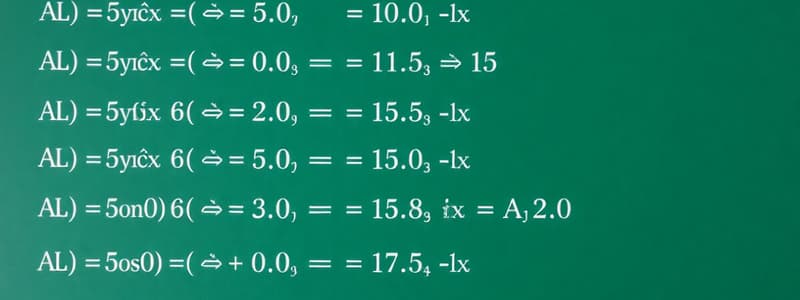Podcast
Questions and Answers
Which of the following statistical tests is most suitable when comparing the means of two independent groups?
Which of the following statistical tests is most suitable when comparing the means of two independent groups?
- Descriptive Statistics
- Correlation
- ANOVA
- T-test (correct)
Inferential statistics primarily focuses on describing the characteristics of a sample rather than making generalizations about a population.
Inferential statistics primarily focuses on describing the characteristics of a sample rather than making generalizations about a population.
False (B)
When conducting a hypothesis test, what are the two possible decisions that can be made regarding the null hypothesis (H0)?
When conducting a hypothesis test, what are the two possible decisions that can be made regarding the null hypothesis (H0)?
Reject H0 or Fail to reject H0
________ statistics are used to summarize and describe the main features of a dataset.
________ statistics are used to summarize and describe the main features of a dataset.
Which statistical test is appropriate to use when you want to test for the difference between the means of three or more groups?
Which statistical test is appropriate to use when you want to test for the difference between the means of three or more groups?
In the context of the content provided, what does a significant p-value in ANOVA indicate?
In the context of the content provided, what does a significant p-value in ANOVA indicate?
To perform ANOVA in Excel, the 'Data processing' Add-in must be enabled.
To perform ANOVA in Excel, the 'Data processing' Add-in must be enabled.
What type of ANOVA is used when studying the effect of multiple predictor variables on a single outcome?
What type of ANOVA is used when studying the effect of multiple predictor variables on a single outcome?
The statistical tests for analyzing relationships between two categorical variables are ______ and Fisher's exact test.
The statistical tests for analyzing relationships between two categorical variables are ______ and Fisher's exact test.
Which of the following represents the correct sequence of steps to perform ANOVA in Excel?
Which of the following represents the correct sequence of steps to perform ANOVA in Excel?
Running three t-tests is sufficient to determine the salary differences among three different degree types.
Running three t-tests is sufficient to determine the salary differences among three different degree types.
Match the statistical test with its corresponding variable type analysis:
Match the statistical test with its corresponding variable type analysis:
Based on the t-test results provided, which degree is likely to yield significantly higher salaries compared to History and Economics?
Based on the t-test results provided, which degree is likely to yield significantly higher salaries compared to History and Economics?
What statistical test is best suited to initially determine if there's any significant difference between the means of multiple groups (more than two)?
What statistical test is best suited to initially determine if there's any significant difference between the means of multiple groups (more than two)?
If an ANOVA test yields a p-value of 0.06, it indicates a statistically significant difference between the groups at the alpha level of 0.05.
If an ANOVA test yields a p-value of 0.06, it indicates a statistically significant difference between the groups at the alpha level of 0.05.
If ANOVA determines a significant difference exists among several treatment groups, what subsequent type of test is typically used to determine which specific groups differ significantly from each other?
If ANOVA determines a significant difference exists among several treatment groups, what subsequent type of test is typically used to determine which specific groups differ significantly from each other?
While ANOVA can tell you that a difference exists among groups, it does not specify which groups are different; identifying those requires additional tests, such as running multiple ____.
While ANOVA can tell you that a difference exists among groups, it does not specify which groups are different; identifying those requires additional tests, such as running multiple ____.
Why it is important to perform an ANOVA before conducting multiple t-tests when comparing more than two groups?
Why it is important to perform an ANOVA before conducting multiple t-tests when comparing more than two groups?
If ANOVA shows no significant difference between multiple groups, it is still appropriate to proceed with multiple t-tests to explore subtle differences.
If ANOVA shows no significant difference between multiple groups, it is still appropriate to proceed with multiple t-tests to explore subtle differences.
In the context of drug trials, what does 'remission at 12 months' typically indicate?
In the context of drug trials, what does 'remission at 12 months' typically indicate?
Define what a p-value represents in statistical hypothesis testing.
Define what a p-value represents in statistical hypothesis testing.
A statistically significant p-value (typically p < 0.05) indicates that the results are unlikely to have occurred by ______ alone.
A statistically significant p-value (typically p < 0.05) indicates that the results are unlikely to have occurred by ______ alone.
Match each statistical test with its primary application:
Match each statistical test with its primary application:
What is the primary purpose of inferential statistics related to t-tests and ANOVA?
What is the primary purpose of inferential statistics related to t-tests and ANOVA?
ANOVA is appropriate to use when comparing only two groups to determine if there is a statistically significant difference between their means.
ANOVA is appropriate to use when comparing only two groups to determine if there is a statistically significant difference between their means.
What are the three main assumptions that should be met when using t-tests and ANOVA for continuous data?
What are the three main assumptions that should be met when using t-tests and ANOVA for continuous data?
When comparing the means of three or more groups, the statistical test used is generally ______.
When comparing the means of three or more groups, the statistical test used is generally ______.
Match the statistical test with its appropriate use case:
Match the statistical test with its appropriate use case:
In inferential statistics, what is the primary purpose of comparing groups using a continuous and a categorical variable?
In inferential statistics, what is the primary purpose of comparing groups using a continuous and a categorical variable?
A paired t-test is best suited for comparing two separate, unrelated groups.
A paired t-test is best suited for comparing two separate, unrelated groups.
What statistical test should be used to compare the means of a continuous outcome variable across three or more groups?
What statistical test should be used to compare the means of a continuous outcome variable across three or more groups?
A small p-value (typically less than 0.05) in a t-test indicates that the difference between the group means is statistically ________.
A small p-value (typically less than 0.05) in a t-test indicates that the difference between the group means is statistically ________.
When conducting an ANOVA, what does the F-statistic primarily help to determine?
When conducting an ANOVA, what does the F-statistic primarily help to determine?
A categorical variable is measured on a continuous scale.
A categorical variable is measured on a continuous scale.
Give an example of a scenario in which a researcher would use a one-way ANOVA.
Give an example of a scenario in which a researcher would use a one-way ANOVA.
Flashcards
Descriptive Statistics
Descriptive Statistics
Summarizes and describes the main features of a dataset.
Inferential Statistics
Inferential Statistics
Enables conclusions about a population based on a sample.
Correlation (Continuous vs Continuous)
Correlation (Continuous vs Continuous)
Measures the relationship between two continuous variables.
T-test
T-test
Signup and view all the flashcards
ANOVA
ANOVA
Signup and view all the flashcards
Analysis ToolPak
Analysis ToolPak
Signup and view all the flashcards
Single Factor ANOVA
Single Factor ANOVA
Signup and view all the flashcards
P-value in ANOVA
P-value in ANOVA
Signup and view all the flashcards
Degrees vs Salaries
Degrees vs Salaries
Signup and view all the flashcards
Two-way ANOVA
Two-way ANOVA
Signup and view all the flashcards
T-tests after ANOVA
T-tests after ANOVA
Signup and view all the flashcards
R functions for ANOVA
R functions for ANOVA
Signup and view all the flashcards
Chi-squared Test
Chi-squared Test
Signup and view all the flashcards
p-value
p-value
Signup and view all the flashcards
Remission Rate
Remission Rate
Signup and view all the flashcards
Multiple Comparisons
Multiple Comparisons
Signup and view all the flashcards
Control Group
Control Group
Signup and view all the flashcards
Experimental Group
Experimental Group
Signup and view all the flashcards
Effect Size
Effect Size
Signup and view all the flashcards
Statistical Significance
Statistical Significance
Signup and view all the flashcards
Post-hoc Tests
Post-hoc Tests
Signup and view all the flashcards
Assumptions of t-tests and ANOVA
Assumptions of t-tests and ANOVA
Signup and view all the flashcards
Purpose of t-tests
Purpose of t-tests
Signup and view all the flashcards
Purpose of ANOVA
Purpose of ANOVA
Signup and view all the flashcards
Homogeneity of variance
Homogeneity of variance
Signup and view all the flashcards
Continuous Variable
Continuous Variable
Signup and view all the flashcards
Categorical Variable
Categorical Variable
Signup and view all the flashcards
Independent t-test
Independent t-test
Signup and view all the flashcards
One-Way ANOVA
One-Way ANOVA
Signup and view all the flashcards
F-statistic
F-statistic
Signup and view all the flashcards
Study Notes
Obesity Levels in England
- Obesity levels have risen among Year 6 children in England.
- Data shows a rising trend from 2006/7 to 2021/22.
Statistical Plot Correlation Examples
- Scatter plots illustrate correlation types.
- Positive correlation: As X increases, Y increases.
- Negative correlation: As X increases, Y decreases.
- No correlation: No discernible relationship between X and Y.
Previously Covered Topics
- Descriptive Statistics (sample & population)
- Inferential Statistics (general concepts)
- Continuous vs. Continuous Data
Today's Topics
- Inferential Statistics (further concepts)
- Categorical vs. Continuous data
- Specific tests: T-test and ANOVA
Types of Errors
-
The ultimate goal of statistics is to separate signal from noise.
-
Hypothesis testing (Ho or H₁).
-
p-value < 0.05: Reject Ho (significant results).
-
p is the probability of a false positive result (type I error).
-
1-p is the chance of a true positive result.
-
Significance level (α) = 0.05.
-
Type I error = false positive.
-
Type II error = false negative (probability denoted by β).
-
Statistical power = 1 - β (ability of a test to detect a signal).
-
False positives are easy to see but hard to interpret.
-
False negatives are hard to see
Types of Errors (cont'd)
- In statistical tests, there are two kinds of errors (false positive and false negative results).
- A false positive occurs if we conclude that there is an effect when, in reality, no effect exists.
- False negatives occur when we conclude there is no effect when, in reality there is an effect.
- Different testing methods might impact the chance of each type of error.
Using T-tests
- A t-test is used to compare means.
- T-tests tell us if there is a significant difference between two measurements or between a measurement and a benchmark.
- T-tests require data in the format of mean, standard deviation and number of points (n).
- Classic way vs. Modern Way: Different approaches to calculate T-tests.
Deciding Which T-Test to Use
- Use a one-sample t-test if comparing one data set to a benchmark.
- Use a paired t-test if comparing two sets of data from the same objects.
- Use an unpaired t-test if comparing two sets of data from different objects.
Example of a Paired T-test
- Used to compare measurements before and after an event (e.g., a treatment).
- Example - comparing a basketball team's jump height before and after a training regimen.
One-tailed or Two-tailed Tests
- One-tailed tests are used to determine if one parameter is larger or smaller than the other.
- Two-tailed tests determine if the two parameters are different from one another.
Stringency in Tests
- One-tailed tests have lower stringency compared to two-tailed tests for determining statistical significance.
Equal Standard Deviation
- When comparing two sets of data, ensure testing for equal standard deviation.
- If unsure, assume the data sets have different standard deviations.
Summarizing T-tests in Excel
- Use Excel's T.TEST function to calculate p-values.
- Provide necessary input arguments for the data, tail type (one or two-tailed) and paired or unpaired.
One-sample T-test
- This test is used to compare one data set to a benchmark (standard).
- Typically involves comparing a sample's characteristics (e.g., test scores) against a certain standard (e.g., required score)
Confidence Intervals
- The confidence interval gives a range of effect sizes that have a specified probability of being true.
- It accounts for the variability in measurements (the standard deviation).
- If the confidence interval includes zero, it suggests there is a chance there is no effect.
Effect Size
- Effect sizes measure the magnitude of differences between groups or conditions.
- Effect size = Mean of condition A − Mean of condition B
ANOVA
- ANOVA is used when we are comparing more than 2 conditions simultaneously.
- Reduces the rate of false positives compared to running multiple T-Tests.
Running ANOVA in Excel
- Enable the Analysis Toolpak add-in.
- Use the ANOVA Single Factor function located in the
Datatab to perform the analysis.
ANOVA Output
- The ANOVA method provides p-values.
- A p-value of less than 0.05 indicates significantly different means between the groups.
Categorical vs. Categorical
- Chi-squared and Fisher are statistical tests used to understand correlations between two categorical variables.
R Programming
- Both t-tests and ANOVAs are available as functions in R for more comprehensive results.
Studying That Suits You
Use AI to generate personalized quizzes and flashcards to suit your learning preferences.




